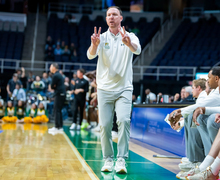MakerSpace provides students with cutting-edge technology
Josh Aviv is working to fight range anxiety.
The Syracuse University senior economics major wants to be able to travel long commutes without having to worry about his electronic car running out of charge. His company SparkCharge aims to eliminate this anxiety in electronic car drivers everywhere.
Although SparkCharge is still a startup company in its working stages, Aviv has used SU as a major resource to help launch his business and sign deals with companies to place electric charging stations across New York. His biggest resource so far has been the new MakerSpace in Kimmel Hall, filled with 3-D printers, laser printers and zSpace virtual reality simulators.
“This has helped my business tremendously,” Aviv said. “This place has been crucial to our success and crucial to getting the word out. From the laser engraved business cards and the physical prototypes — I love it.”
The MakerSpace opened in the beginning of the fall semester and had its first open house last Friday. Students watched as the 3-D printers created spaceships, cubes and elephant prototypes right before their eyes.
The MakerSpace, which shares a space with the Kimmel computer lab, was designed and is managed by the Information Technology and Services Academic Services’ Learning Environments unit. Jenny Gluck, ITS’s associate chief information officer for academic services, said the space has been in the works since 2011 and is open to students of all majors.
“The students that have been coming in — it’s mostly been through word of mouth,” Gluck said. “Most of the students that come in have an idea, and they type that in and they print it. What’s nice is that if it doesn’t work, they can do it again and again.”
Gluck said that the goal of the MakerSpace is to have all the tools for students to make a prototype to eventually pitch to a company, like Aviv did with his charging stations. From vinyl cutters, to wire benders, to over half a dozen printers, there is no lack of resources in the center for students to use.
“We thought, ‘What would give students a chance to experiment and grow and give them a chance to do things somewhat easily on their own that they wouldn’t be able to do in their residence halls?’” Gluck said. “It gave students the chance to explore in another area that they’re not used to, but give them an advantage in technology.”
A big incentive to use the space, Gluck said, is that the materials used to create the printouts are recyclable. It’s OK if students mess up and reprint — they can just toss the rejected product in the recycle bin.
Another incentive is that it’s mostly free, said John Mangicaro, the lead facilitator of the Makerspace. If the students have big projects, ITS will ask them to bring in their own roll of materials, which costs about $30 and lasts for multiple printing projects.
Mangicaro’s job is to make sure the technology in the lab keeps working, and that students understand how to properly use it. He added that if students don’t know how to use the materials in the MakerSpace, they can ask any of the ITS employees, who are SU students, and learn in a matter of 20 minutes or less.
“It’s a lot simpler than people think,” Mangicaro said. “You don’t have to be an engineer. You can do stuff relatively easy and fast.”
So far, the space has been filled with students who are interested in creating projects for class or just for fun, Mangicaro said.
One of the most memorable projects Mangicaro has seen is a hand with finger joints and tendons students made using 3-D printers. He said that the point of the space is to promote creativity and a fun environment.
“People are really happy to be here. People just hang out here,” Mangicaro said. “There’s a lot going on, a lot of people working together.”
Gluck said that as more students hear about MakerSpace, she hopes more students will come and experience the technology. It’s a tool that students all across SU’s campus should take advantage of.
“We’re ready and we’re excited about it,” Gluck said. “We want it to be a place where students want to come and aggregate — a place where faculty want to come and build a community.”
Published on October 14, 2014 at 12:01 am
Contact Jackie: jmfrere@syr.edu | @jackie_frere





